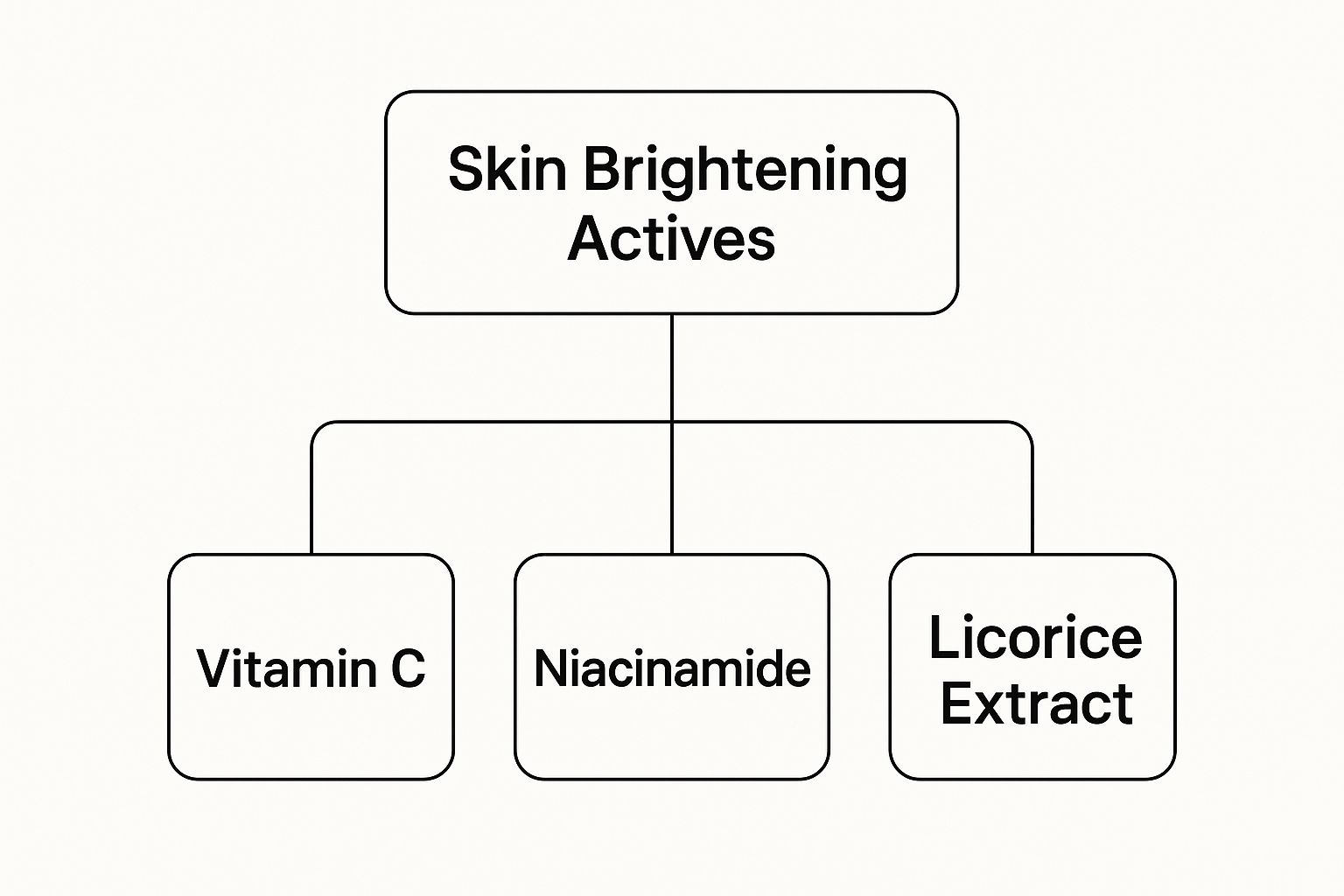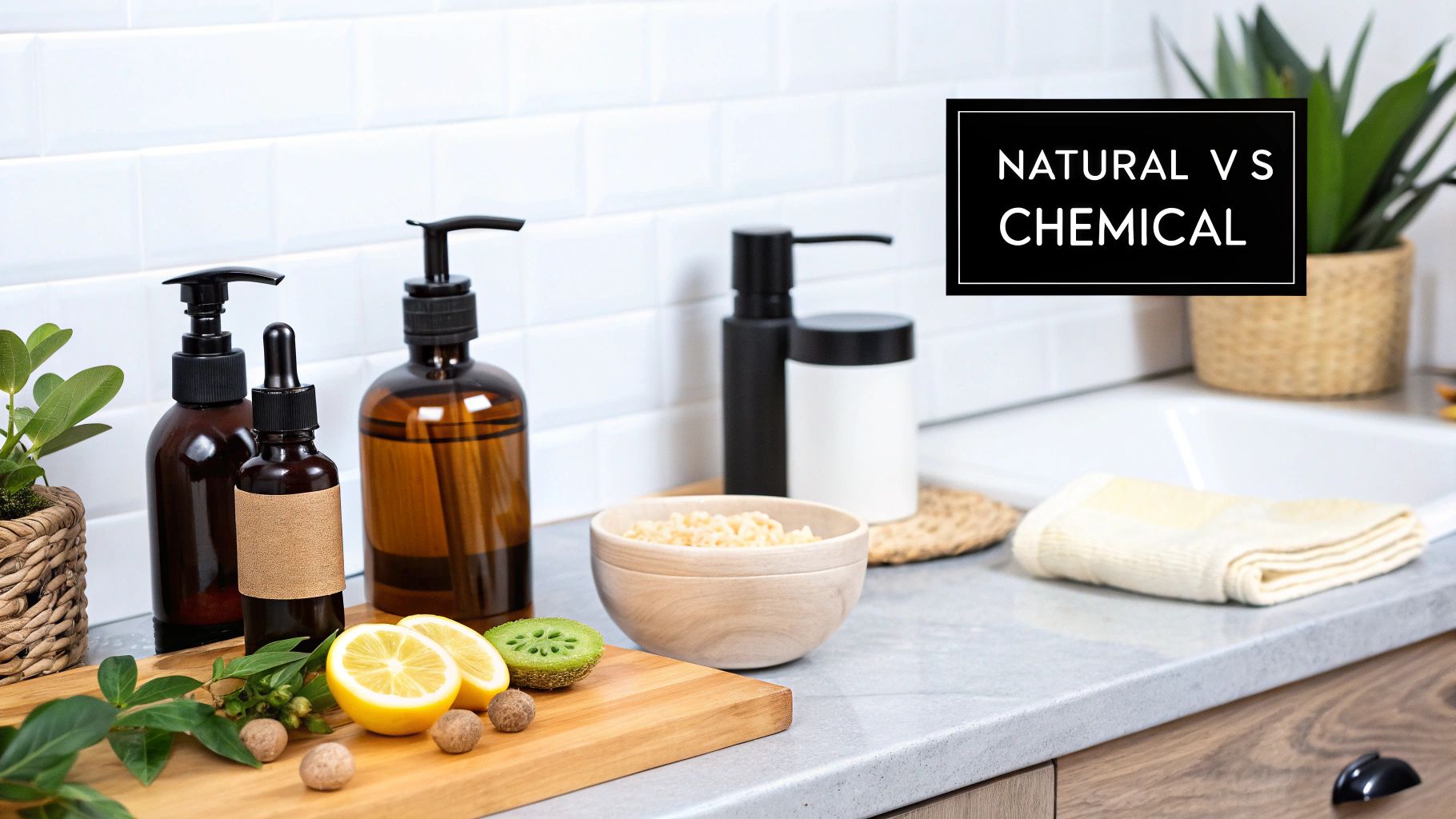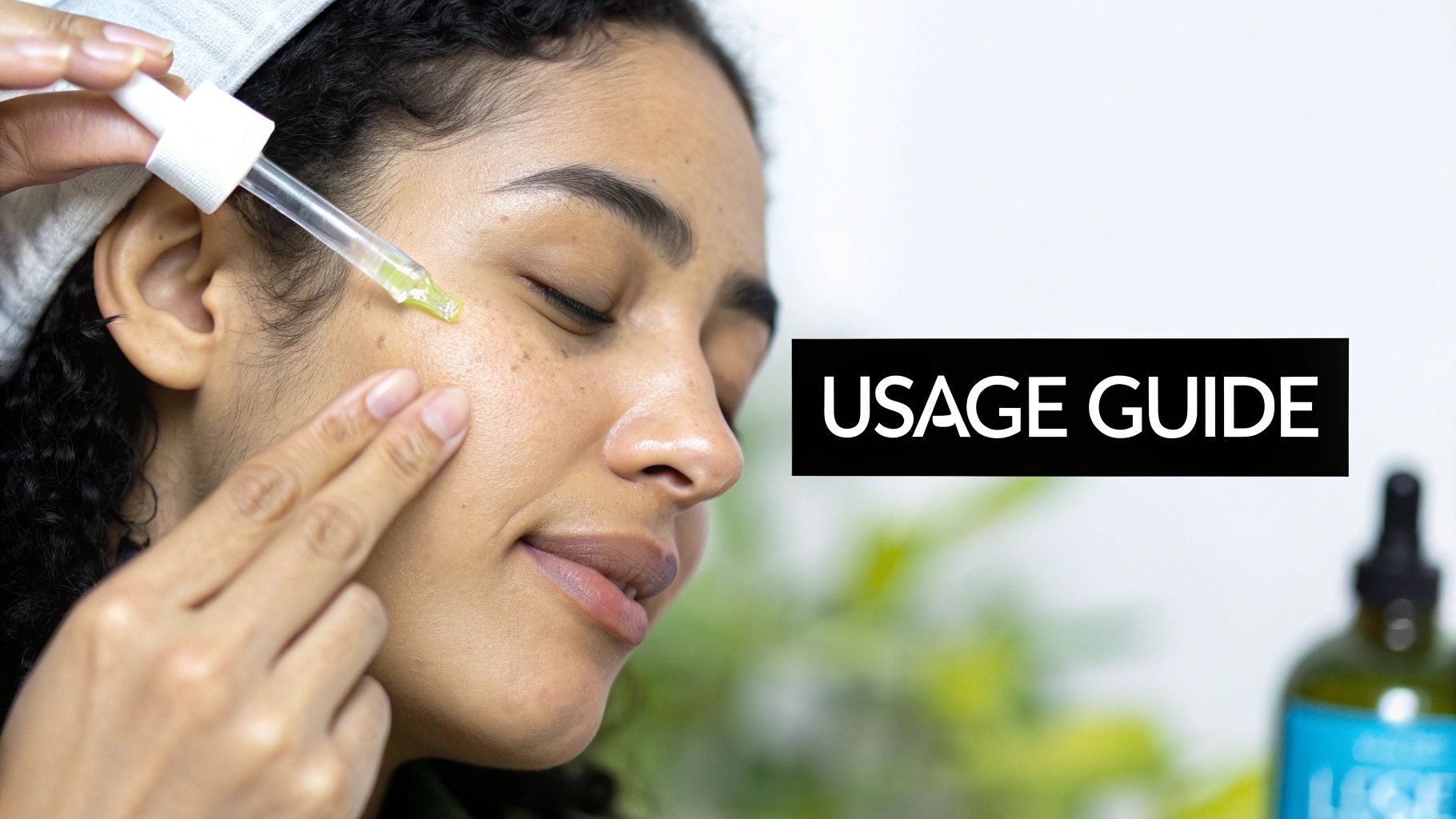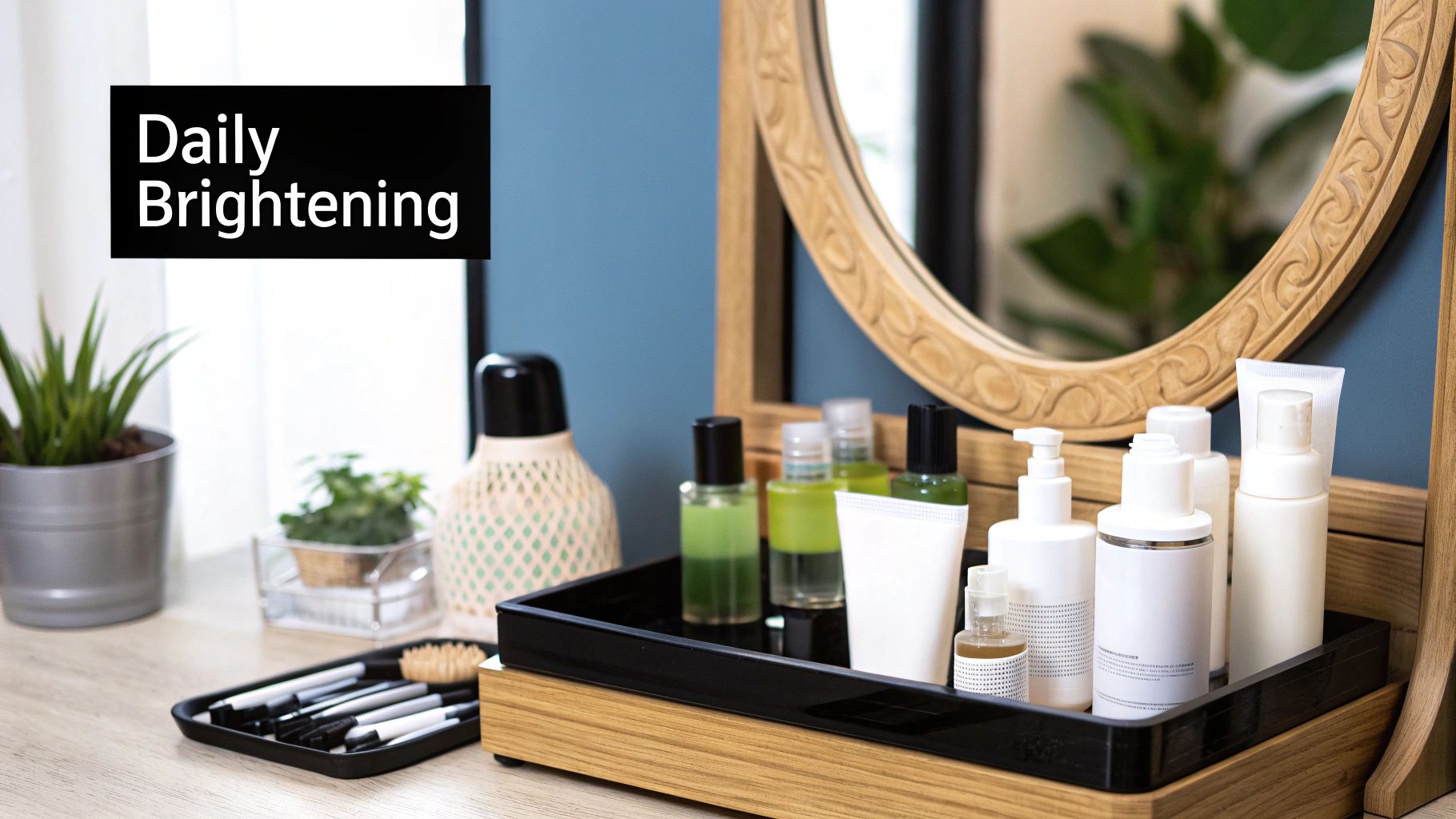Jan Elvis
03.10.2025

Jan Elvis
03.10.2025
When you hear the term "skin brightener," it's easy to jump to the wrong conclusion. A lot of people think these products are meant to change their actual skin color. That’s a huge misconception.
Think of a great skin brightener more like a photo editor for your complexion. It doesn’t create a new image; it just enhances the one you already have by restoring its natural luminosity and evenness. Its real job is to tackle dullness and fade discolored spots, leaving you with a healthier, more vibrant look.
Let's clear the air right away: skin brightening has nothing to do with bleaching or fundamentally altering your natural skin tone. It’s all about correcting discoloration and bringing back your skin's inherent glow.
Essentially, it’s like hitting a reset button for skin that’s become uneven from things like sun damage, leftover acne marks, or inflammation. The main target here is hyperpigmentation. This is just a clinical-sounding term for when your body goes into overdrive producing melanin—the pigment that gives skin its color—in specific spots. The result is those pesky dark patches, sun spots, or marks that stick around long after a pimple is gone.
A good skin brightener fights this on two fronts:
This one-two punch is what makes these products so effective. They’re working below the surface to fix the root of the problem while also improving the texture and radiance you see in the mirror.
It’s really important to know the difference between these terms. They get tossed around interchangeably, but they are not the same thing.
The desire for a safe, even skin tone has fueled a massive industry. The global market for products tackling pigmentation was valued at around USD 12.27 billion and is expected to climb to USD 18.91 billion by 2033, with a steady growth rate of 5.56% each year.
The real goal of a skin brightener isn't to give you a new skin tone, but to reveal the healthiest, most radiant version of the skin you were born with.
For anyone struggling with stubborn discoloration, at-home products are a fantastic place to start. If you find you need a bigger boost, exploring professional skin brightening services can provide more intensive treatments under the care of an expert. At the end of the day, the right skin brightener simply helps you achieve a clear, uniform glow.
When you're on the hunt for the best skin brightener, the real magic is always in the ingredient list. Learning what these key compounds do is like finally understanding what your skin is trying to tell you. Instead of taking a shot in the dark, you can pick a product that directly targets your unique concerns, whether that’s a few stubborn dark spots or just an overall lack of glow.
Think of these ingredients as a team of specialists, each with a very specific job. Some are defenders, shielding your skin from the environmental stressors that cause dullness. Others are renovators, helping to shed old cells and reveal the fresh, new skin underneath. Let’s get to know the most effective players you'll find in the best brightening formulas.
Vitamin C, often appearing on labels as L-ascorbic acid, is a skincare celebrity for good reason. Its main gig is as a powerful antioxidant. Picture it as a personal bodyguard for your skin cells, neutralizing the damage from free radicals—those pesky, unstable molecules caused by UV rays and pollution that lead to discoloration and premature aging.
By fighting off this daily stress, Vitamin C not only helps prevent new spots from showing up but also works on fading the ones you already have. It gets in the way of the enzyme that creates melanin, essentially turning down the dimmer switch on hyperpigmentation. This helps even out your skin tone, leaving you with that vibrant, healthy look. To dig deeper, you can explore the benefits of powerhouse ingredients like Vitamin C serum.
Niacinamide, a form of vitamin B3, is the ultimate multitasker. Its real genius is in its ability to strengthen your skin's natural barrier—that crucial outer layer responsible for locking moisture in and keeping irritants out. A healthy barrier means stronger, more resilient skin that’s less likely to get red and angry.
But its brightening skills come from a totally different angle. Niacinamide actually blocks the pigment from traveling from your melanin-producing cells up to the surface of your skin.
So, even if your skin is overproducing melanin deep down, niacinamide helps stop that pigment from ever becoming a visible dark spot. It intercepts the problem before it even starts.
This makes it fantastic for minimizing the appearance of old acne marks and promoting a beautifully even complexion. After all, a huge part of bright skin is healthy, hydrated skin—the foundation for that sought-after glow. For more on this, check out our guide on how to get dewy skin.
If you’re dealing with very specific, stubborn dark spots from sun damage or old breakouts, Alpha Arbutin is the specialist you call in. This ingredient, which comes from the bearberry plant, is known for its incredible precision. It works by slowly releasing its active component to inhibit tyrosinase, the main enzyme needed to produce melanin.
It’s like a sniper targeting only the overactive pigment cells instead of taking a blanket approach. This makes it a much gentler option that’s still highly effective, especially for sensitive skin types that can't handle more aggressive ingredients. Its focused action makes it a go-to for fading sun spots and melasma without messing with the skin around them.
To help you choose, here's a quick look at how these popular brightening ingredients stack up against each other.
| Ingredient | Primary Function | Best For | Skin Type Suitability |
|---|---|---|---|
| Vitamin C | Antioxidant protection, inhibits melanin production | General dullness, sun damage, preventing future spots | Most skin types, but high concentrations can irritate sensitive skin |
| Niacinamide | Strengthens skin barrier, blocks pigment transfer | Post-acne marks, redness, uneven skin tone | Excellent for all skin types, including sensitive and oily |
| Alpha Arbutin | Inhibits tyrosinase with precision | Stubborn dark spots, sun spots, melasma | Great for all skin types, especially sensitive skin |
| Retinoids | Speeds up cell turnover | Fading surface discoloration, fine lines, uneven texture | Best for non-sensitive, acne-prone, and mature skin; introduce slowly |
Choosing the right active ingredient really comes down to pinpointing your main skin concern, from overall brightness to targeted spot treatment.
Here’s a breakdown of some of the most popular actives found in the best skin brightener products.

This visual highlights how core ingredients like Vitamin C and Niacinamide are essential building blocks for any truly effective brightening routine.
Retinoids, the family of vitamin A derivatives that includes retinol, are the undisputed gold standard for skin renewal. They work by putting your cellular turnover into overdrive, which just means they speed up the process of shedding old, dead cells and bringing fresh, new ones to the surface. This rapid exfoliation is amazing for diminishing the appearance of discoloration that sits on the skin's surface.
By constantly encouraging this renewal cycle, retinoids don’t just fade hyperpigmentation—they also dramatically improve skin texture and soften fine lines. They are true workhorses for achieving a complexion that’s smoother, clearer, and far more luminous over time.

Navigating the world of skincare can feel like trying to find the right key for a very specific lock. Not every brightener works for everyone, and the best skin brightener is always the one that’s a perfect match for your skin’s unique needs. To get it right, you have to look past the flashy marketing and focus on your specific skin type and what you're trying to achieve.
Think of it this way: you wouldn't use the same fertilizer for a cactus that you would for a rose bush. In the same vein, what works wonders for oily skin might be a disaster for someone with dry or sensitive skin. This personalized approach is what separates frustrating trial-and-error from seeing real, lasting results.
If you’re constantly battling excess oil or breakouts, your main goal is to find a brightener that won’t clog your pores or make you look even shinier. Your best friends are lightweight textures. Think fast-absorbing serums and gel-based formulas that feel like nothing on the skin.
For this skin type, niacinamide is a true superstar. It's fantastic at fading those stubborn post-acne marks, but it also does double duty by helping regulate oil production and strengthening your skin's barrier. A great formula will help you achieve a balanced, even glow, not a greasy sheen. Pairing your brightener with one of the best skin toners can also be a game-changer for controlling oil and prepping your skin for what's next.
For anyone with dry or mature skin, the mission is all about hydration, hydration, hydration. A brightener that also deeply moisturizes is exactly what you need. When skin is dehydrated, it can look dull and make fine lines appear more prominent, so tackling dryness is just as crucial as fading dark spots.
Keep an eye out for richer, creamier serums or lotions that pack a hydrating punch alongside their brightening actives. Vitamin C is an incredible choice here; it's a powerful antioxidant that protects against environmental stressors while also firing up collagen production to help firm things up. When you see it combined with hyaluronic acid, you've found a powerhouse product that brightens and quenches thirsty skin all at once.
Your ideal brightener should feel like a nourishing drink for your skin, leaving it feeling plump and looking luminous, not tight or stripped. This dual-action approach is essential for achieving a healthy, youthful glow.
Sensitive skin demands a gentle touch. The wrong ingredient can quickly trigger redness, stinging, or irritation, which completely defeats the purpose of your brightening routine. The goal is to find ingredients that are effective but also soothing, working with your delicate skin barrier, not against it.
A fantastic option for sensitive complexions is alpha arbutin. It's known for being incredibly precise in targeting hyperpigmentation without causing the irritation that stronger actives can. It’s a much safer bet. Also, seek out formulas that are fragrance-free and include calming ingredients like licorice root extract or allantoin to give your skin extra support. And, as always, don't forget to patch-test any new product before slathering it all over your face.

Finding a great skin brightener feels like a huge win, but that product can't do all the heavy lifting on its own. Consistency and proper application are what really transform good ingredients into great results. The single most important step you'll take on your journey to radiant skin is building a solid daily routine and sticking with it.
Think of it like building a house: you need a solid foundation, and every layer has to go on in the right order. If you put the roof on before the walls, you’ve got a problem. Skincare is the same way. Layering products correctly ensures each one can actually penetrate your skin and work its magic without being blocked by something you put on before it. Getting the skin care order of application right is everything.
Your morning routine is all about protection. You're basically suiting up your skin to face a day full of environmental attackers like UV rays and pollution—two of the biggest culprits behind dullness and dark spots.
At night, your skin’s job switches from defense to repair. This is the perfect window to bring in your more powerful treatments because they can work deeply and without interruption while you sleep.
Key Tip: Before you slather a new product all over your face, always patch-test it first. Apply a small amount to a discreet area, like behind your ear, and wait 24 hours to see if any irritation pops up. When introducing potent ingredients like retinoids, start slow—maybe two or three times a week—and let your skin build up a tolerance before increasing how often you use it.
Patience is part of the process. It's no surprise that the global market for skin lightening products, valued at USD 9.96 billion, is expected to soar to USD 16.14 billion by 2030. People are tired of products that don't work and are demanding real solutions for concerns like age spots and old acne marks. You can read more about the trends in the skin lightening market on grandviewresearch.com. But the secret to getting those results isn't a miracle product; it's a smart, consistent routine.

Starting any new skincare routine is exciting, but it’s so important to have realistic expectations right from the beginning. Getting a brighter, more even-toned complexion is definitely a marathon, not a sprint. The best skin brighteners work in sync with your skin's natural cell turnover cycle, and that process simply takes time.
Think about it like starting a new fitness plan. You won't see a six-pack after one workout, but if you stick with it consistently for weeks and months, the results become obvious. Skincare is no different—patience and consistency are your best friends.
So, what can you actually expect to see, and when? The path to brighter skin usually happens in phases, with small, subtle improvements building up to more dramatic changes over time.
Here's a general timeline:
Weeks 2-4: The Initial Glow. Within the first month, you’ll probably start to notice a subtle, healthy-looking glow. This is often the first sign things are working, usually thanks to better hydration and the gentle exfoliating effects of your new products.
Weeks 8-12: The Fading Begins. This is where the real magic starts to happen. After about two to three months of consistent use, you should see a visible reduction in hyperpigmentation. Dark spots and old acne marks will finally start to look lighter and less noticeable.
Stick with your routine, even if the progress feels slow at first. The most significant changes happen with sustained use, as your skin needs time to complete several renewal cycles for those deeper pigmented cells to reach the surface and shed.
Sometimes, your skin just needs a little time to get used to new things. When you introduce potent ingredients like retinoids, it’s not uncommon to experience a bit of "purging," where underlying breakouts come to the surface. It can be frustrating, but it's usually a good sign that the ingredient is working to clear out your pores.
If you notice any dryness or mild irritation, don't panic. Just pull back a bit. Try applying the product every other day until your skin gets comfortable. The most important thing is to listen to what your skin is telling you and adjust as you go.
The skincare world is always coming up with better formulas. New ingredients and delivery systems are constantly being developed, with a huge focus on creating effective, natural products to tackle hyperpigmentation. If you're curious about what's driving this progress, you can learn more about skin brightening market drivers on fortunebusinessinsights.com.
Understanding the process from the start will help you stay motivated long enough to see the beautiful, lasting results you're after.
https://www.youtube.com/embed/EBUB7qeP4Qg
Even with the perfect skin brightener sitting on your shelf, a few questions are bound to come up. Let's be honest, navigating active ingredients can feel tricky, and getting clear answers is the key to feeling confident in your routine.
This is your go-to guide for those nagging "what if" and "how-to" questions. We'll cut through the confusion with straightforward advice to help you get the glow you're after without any guesswork.
Yes, but with a smart strategy. The last thing you want to do is throw a bunch of powerful active ingredients at your skin all at once—that’s just asking for irritation. For instance, layering a potent Vitamin C serum and a retinol cream in the same application can easily overwhelm your skin, leading to redness and sensitivity.
The better way to do it is to alternate. Think of it as giving your star players their own time to shine.
This approach lets you reap the rewards of multiple ingredients without compromising your skin barrier. And a golden rule: always introduce new products one at a time. Give your skin a week or two to adjust before you think about adding something else to the mix.
Absolutely. Today's best brighteners are formulated to work beautifully and safely on the entire spectrum of skin tones, from the very fairest to the deepest. The key is that quality ingredients like Vitamin C, niacinamide, and alpha arbutin don't target your skin's natural, beautiful color. Instead, they focus on inhibiting excess pigment production.
Their goal is to restore your skin's clarity by fading dark spots and correcting unevenness—not to bleach your skin. That said, those with deeper skin tones should be a little more cautious with aggressive in-office treatments, as there can be a higher risk of post-inflammatory hyperpigmentation if the skin becomes overly irritated.
A great skin brightener works with your skin, not against it. It aims to reveal a uniform, luminous complexion by tackling discoloration, never by changing your inherent skin tone. It’s all about letting your healthiest skin shine through.
Think of a brightening product as a long-term commitment to your skin's health, not a short-term fix. While you’ll probably see a real difference in dark spots after a few months, the truth is that our skin is always at risk of developing new spots, especially from sun exposure.
It's all about maintenance. Sticking with a gentle brightener—and, most critically, wearing a broad-spectrum sunscreen every single day—is the secret to keeping your complexion even and radiant for the long haul. Consistency is what locks in your results and prevents future discoloration from showing up.
Ready to build a routine that makes you feel amazing in your own skin? The products at Main Character are all about helping you look and feel your best, day in and day out. Find your next skincare favorite at https://www.dontlooktrash.com.